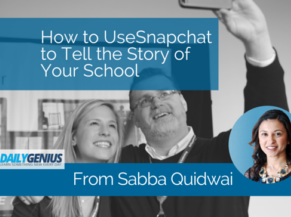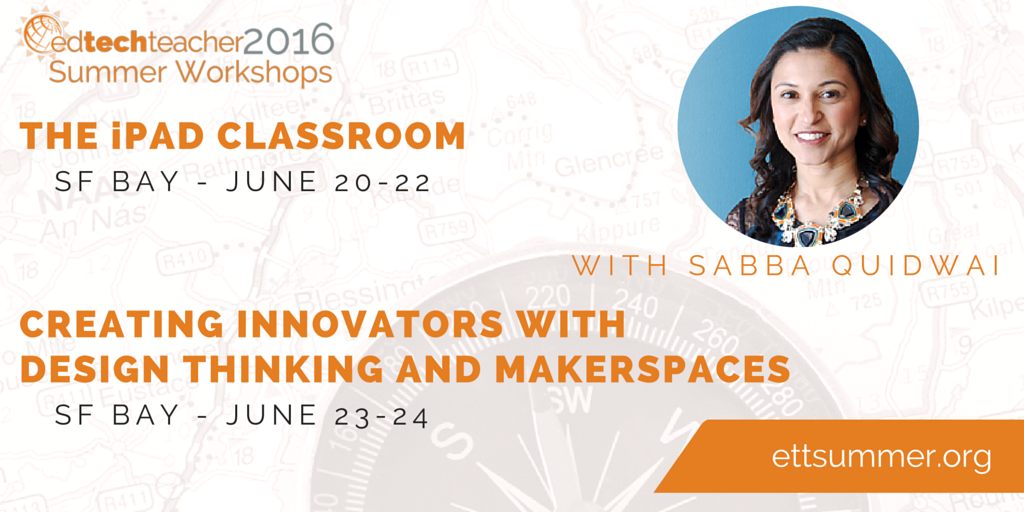This post first appeared on Daily Genius.
The power of a story should not come as a surprise to anyone. Throughout human history, the joy of telling and sharing stories has remained constant. Sharing the stories of what we do in education is not something new either. We often hear, “If you do not tell your story then someone else will.” As a result, we’ve seen lots of workshops, articles, and conversations about the importance of telling our story and the importance of tweeting, blogging, and branding. What we often fail to talk about, though, is to whom are we telling our story and whether it is reaching them.
In the book, “Jab, Jab, Jab, Right Hook,” Gary Vaynerchuk explains that a great story is one that sells and markets a brand. It creates an emotional tie to a product and makes consumers do what you ask them to do. In education, we need to be cognizant that we are also marketers and need to be in the business of selling. Our product - creating future problem solvers.
I know just how powerful these stories can be. I got the position of Director of Innovative Learning for the Primary Care Physician Assistant Program at the Keck School of Medicine of USC as a direct result of powerful storytelling. I shared this story during the Apple Distinguished Educators Institute in Miami last year, and you can view it here.
I often ask these questions of myself when I think about sharing a story:
- Am I telling my story to the people in my Twitterverse? People who already know and believe in my message?
- Am I telling my story to the parents in my classroom?
- Am I telling the story to the community within which I live?
- Am I telling my story in the hopes that the mainstream media will come along and pick up my idea and share it?
Vaynerchuk continues to explain that when creating your story, “Content is king, but context is God.”
While many other social media platforms allow you to share content, Snapchat is one of the few that lets you share content and context in just a few seconds, which is why I think it is the ultimate marketing tool to tell your story. With Snapchat, your story and message aren't cut up into bits and pieces across a person’s newsfeed; it’s a continuous stream where you see the development of an idea, activity, or thought from start to finish. Moreover, I believe this platform can create a more meaningful dialogue about the changes around us and how education must transform to give students the skills they need to succeed. If you are new to Snapchat, take a few moments to read this excellent post from A.J. Juliani, The Complete Guide to Snapchat for Teachers and Parents.
I first joined Snapchat because my sisters and younger cousins were using it. Initially, I saw it as just another video platform, similar to Dubsmash, Vine, etc. But then, during an update, Snapchat introduced the game changer - Stories. I started off watching the stories put together by CNN, Food Network, and National Geographic. What I found even more fascinating were the live stories that Snapchat was aggregating from around the world. Each day, I would wake up excited to discover what the live story of the day would be. I found myself captivated by these stories, curated by different people to tell the story of who they were, the country they were from, or the event that was being shared. Above all, I found myself learning about all of these different things, which challenged my existing understanding. Snapchat struck me as an important tool with the power to help people develop empathy for situations or places that were unfamiliar because often, you can’t understand something or someone until you see or hear from them.
I began creating my own stories and sharing my small world. These were not edited, filtered moments, but rather they were live and authentic 10s snaps that allowed people to see the story of my day. I immediately found myself having conversations about the work I do, the role of technology in education with people who I had never had discussions with before. My cousins were asking me questions about how they could use some of the ideas I was sharing in their learning. I had friends sharing concerns about technology and asking for advice about schools. I had teachers who weren’t following me on Twitter (where I primarily share this work) asking about how they could begin doing it within their classrooms as well.
Not every new app that comes along has to be used in our classrooms to “engage” students. I think it’s important to keep in mind that the appeal of Snapchat is that students view it as an “adult-free” zone. As Tom Daccord, so eloquently says, “We are teachers not amusement park directors.”
There’s a small but growing number of teachers sharing their use of Snapchat, and as more and more of us get on, I think it’s crucial to ask, what story do I want to tell and who is my audience? Here are two examples of teachers using Snapchat beyond their lessons.
A Day in the Class of...
One of the most effective, yet logistically challenging forms of professional development, is to be able to visit the classroom of another teacher. Hearing about a lesson is one thing, but seeing it in action and being a part of it is another. Snapchat allows teachers to share the story of their day. One of my favorite teachers that I get to visit every day is Ann Kozma. Ann is a TOSA (Teacher on Special Assignment) in Fullerton, CA, and watching Ann’s snap story has provided me with more insight about what learning looks like at her school than any Tweet, Instagram, or Facebook post ever could have. Take a look at this Snapchat story that Ann shared, and you’ll see what I mean for yourself. As a result, you can imagine how many people get ideas for what is possible.
Beyond the School Walls
While visiting the classroom of Mike Saracini, a teacher at Freedom Middle School in Berwyn, IL, I learned that he doesn’t use Snapchat to have students share stories with him, but he encourages them to tell the story of their learning and share it with their peers. He wants other students to see the learning experiences his students are having and be inspired. While there, his students were creating newscasts on the pros and cons of the dropping of the atomic bomb. About an hour after this conversation, here is a message he sent me,
“I wanted to fill you in as a follow-up to our discussion today about Snapchat while you were at Freedom Middle School (I met you during lunch). So, I told you that I want students to share their learning (activities related to our learning wherever it maybe). Well, it happened! A student snapped out from home the work she was doing to prepare for our assessment on, "If America was correct dropping the atomic bomb on Japan?" She had a pro and con list, and a subtitle that said: 'Still debating this atomic bomb issue.' Others snapped her back discussing it. What more could I possibly ask for?”
While using Snapchat in lessons may engage students, the above example empowers students to use the platforms they have to create dialogue and share what’s happening in their schools with their peers.
When students are able to join you as storytellers and share what they are able to do with those who may not have the same opportunities, they act as advocates and empower others to seek out those opportunities as well. As educators, we don’t have to use all the tools that come out in our lessons, but we can definitely use them to empower ourselves and our students to share the stories of ourselves and our learning to help others understand us and what we do and why we do it a little bit better.
How will you tell the story of your learning?
Come find out this summer! From Digital Portfolios to Creating Digitally Curious Classrooms, we have over 18 different topics in 7 cities across the country. Get started at ettsummer.org.


